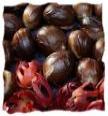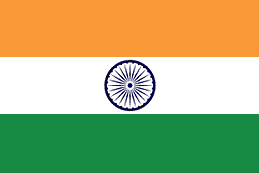Nutmeg & Mace

Nutmeg & Mace
Botanical Name
Myristica fragransFamily
MyristicaceaeCommercial Part
SeedDescription
Nutmeg & Mace are two distinctly different spices produced from a fruit of an evergreen tree usually 9-12 mtr high. Mace is the dried reticulated ‘aril’ of the fruit and nutmeg is the dried seed kernel of the fruit. The trees are normally unisexual, bearing either male or female flowers. The male flowers are born in clusters, whereas female flowers are often solitary. Fruit is a fleshy drupe, spherical in shape, pale yellow in colour with a longitudinal groove in the centre. When the fruit mature it burst open along the groove exposing the bright attractive mace, covering the hard black, shiny shell of the seed called nutmeg.
Origin and Distribution
Nutmeg tree is indigenous to Moluccas. The major nutmeg growing areas are Indonesia and Granada. It also grows on a smaller scale in Sri Lanka, India, China, Malaysia, Zanzibar, Mauritius and Solomon Island. Nutmeg thrives well in places with warm humid climate from sea level up to 600 mtrs MSL. It grows on a variety of soils from sandy to clayey loams and red laterite soils with good drainage. A well-distributed annual rainfall of 250 cm is ideal for the crop.
Uses
Both nutmeg and mace are used as condiment particularly in sweet foods. The spice in the ground form is mainly used in the food processing industry especially as a standard seasoning in many Dutch dishes. Nutmeg oleoresin is used in the preparation of meat products, soups, sauces, baked foods, confectionaries, puddings, seasoning of meat and vegetable etc. The fleshy outer cover of the fruit is crystallized or pickled or made into jellies. Mace is used in savoury dishes. It is used as a drug in Eastern countries because of its stimulant, carminative, astringent and aphrodisiac properties. Excessive doses have a narcotic effect. Nutmeg oil is used in cosmetics and toiletries.
Indian Name of Spices
Hindi : Jaiphal Bengali : Jaiphal Gujarati : Jaiphal Kannada : Jayikai Kashmiri : Zaaphal Malayalam : Jathikka Marathi : Jaiphal Oriya : Jaiphala Punjabi : Jaiphal Sanskrit : Jatiphala Tamil : Jathikai Telugu : Jajikai Urdu : Jaiphal
Foreign Name of Spices
Arabic : Jouza at-Teeb Chinese : Dou kou shu Dutch : Nootmuskaat French : Muscade German : Muskatnu Greek : Moschokarido Indonesia : Pala Italian : Noce moscata Spanish : Moscada







